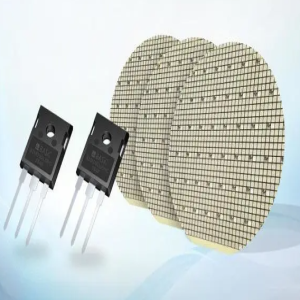
As a new semiconductor material, silicon carbide (SiC) power devices have important application prospects in the field of efficient energy conversion. The basic characteristics, advantages and application prospects of silicon carbide power devices in energy conversion are briefly introduced below.
1. Basic characteristics of silicon carbide power devices
Silicon carbide power devices are a kind of semiconductor devices made of silicon carbide materials. Common silicon carbide power devices include silicon carbide MOSFET (metal oxide semiconductor field effect transistor), silicon carbide Schottky diode, silicon carbide JFET (junction field effect transistor), etc. These devices are different from traditional CM8880PI Compared with silicon based power devices, they have the following outstanding characteristics:
-High operating temperature: silicon carbide devices can operate in a higher operating temperature range, making them more stable and reliable under high temperature environment.
-Lower conduction loss: silicon carbide devices have lower conduction loss, which can achieve higher energy efficiency, and are suitable for applications at high frequencies and temperatures.
-High breakdown voltage: silicon carbide devices have high breakdown voltage, can support higher voltage levels, and are suitable for high voltage and high power applications.
-Fast switching speed: silicon carbide devices have fast switching speed and small switching loss, which is suitable for applications requiring fast switching.
2. Advantages of silicon carbide power devices
Compared with traditional silicon based power devices, silicon carbide power devices have many advantages, including but not limited to:
-High temperature performance: silicon carbide devices have a wide operating temperature range, can work stably in high temperature environments, and are suitable for extreme environment requirements.
-High efficiency: silicon carbide devices have low conduction and switching losses, which can improve the energy utilization efficiency of the system and reduce energy consumption.
-Small size: silicon carbide devices have high electron carrier migration speed, which can produce devices with smaller size and higher power density, and are suitable for compact space design.
-High frequency characteristics: silicon carbide devices have fast switching speed and good high-frequency characteristics, suitable for high-frequency power conversion applications.
3. Application prospect of silicon carbide power devices in energy conversion
Silicon carbide power devices will play an important role in the field of energy conversion, and their application prospects are mainly reflected in the following aspects:
-Power electronics: silicon carbide power devices are widely used in the fields of variable frequency speed regulation, photovoltaic inverter, grid AC transmission, etc., improving the efficiency and reliability of the power system.
-New energy vehicles: silicon carbide devices can be used in power control systems of new energy vehicles such as electric vehicles and hybrid electric vehicles, improving energy efficiency and driving performance.
-Industrial control: the application of silicon carbide devices in industrial control equipment, CNC machine tools, converters, etc. can achieve more efficient energy conversion and accurate control.
-Energy storage: the application of silicon carbide power devices in the energy storage system can improve the energy storage efficiency, reduce energy waste, and promote the large-scale application of renewable energy.
In the future, with the further maturity and popularization of silicon carbide technology, silicon carbide power devices will be more widely used in various fields, making greater contributions to energy conversion, energy conservation and emission reduction.

